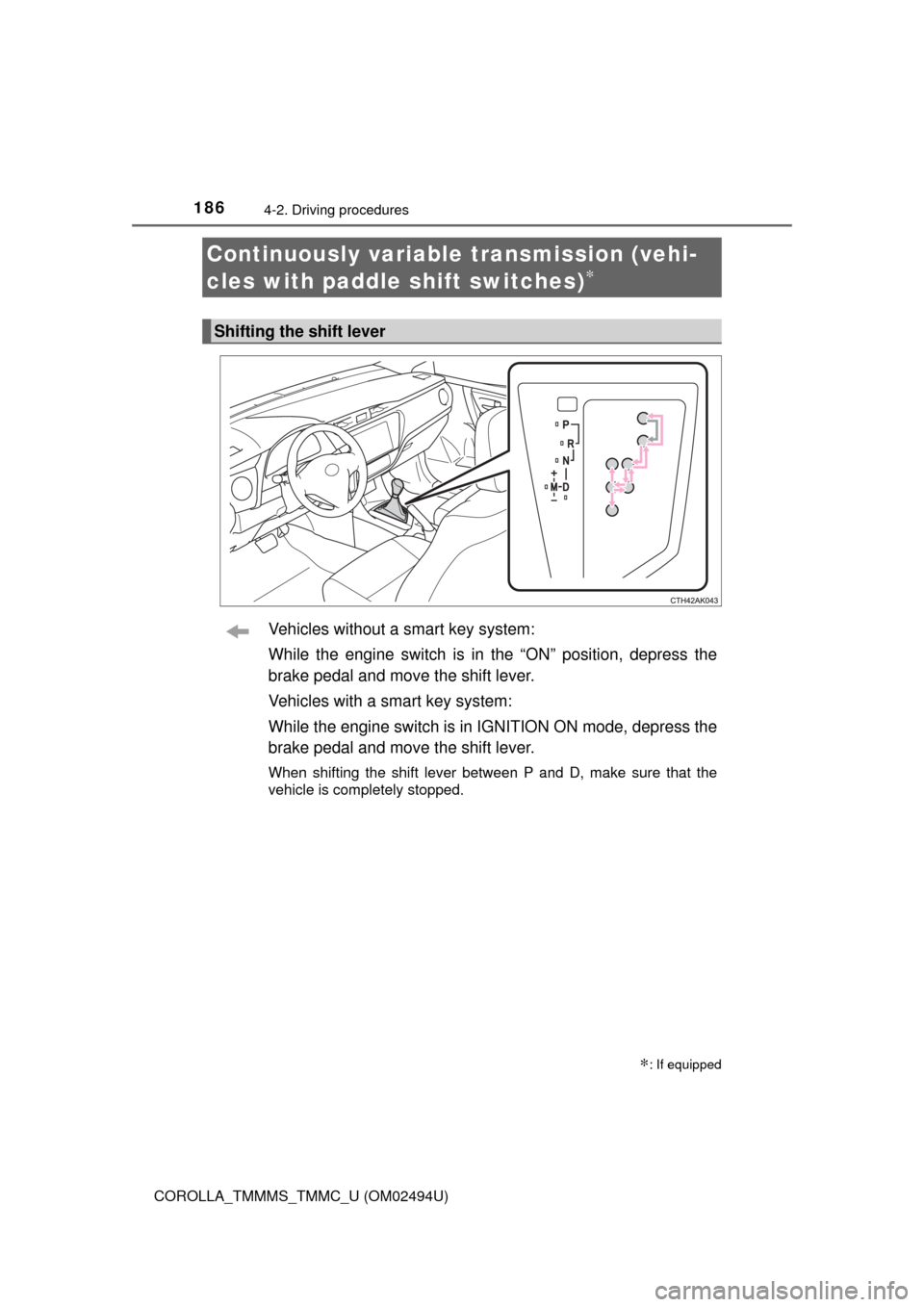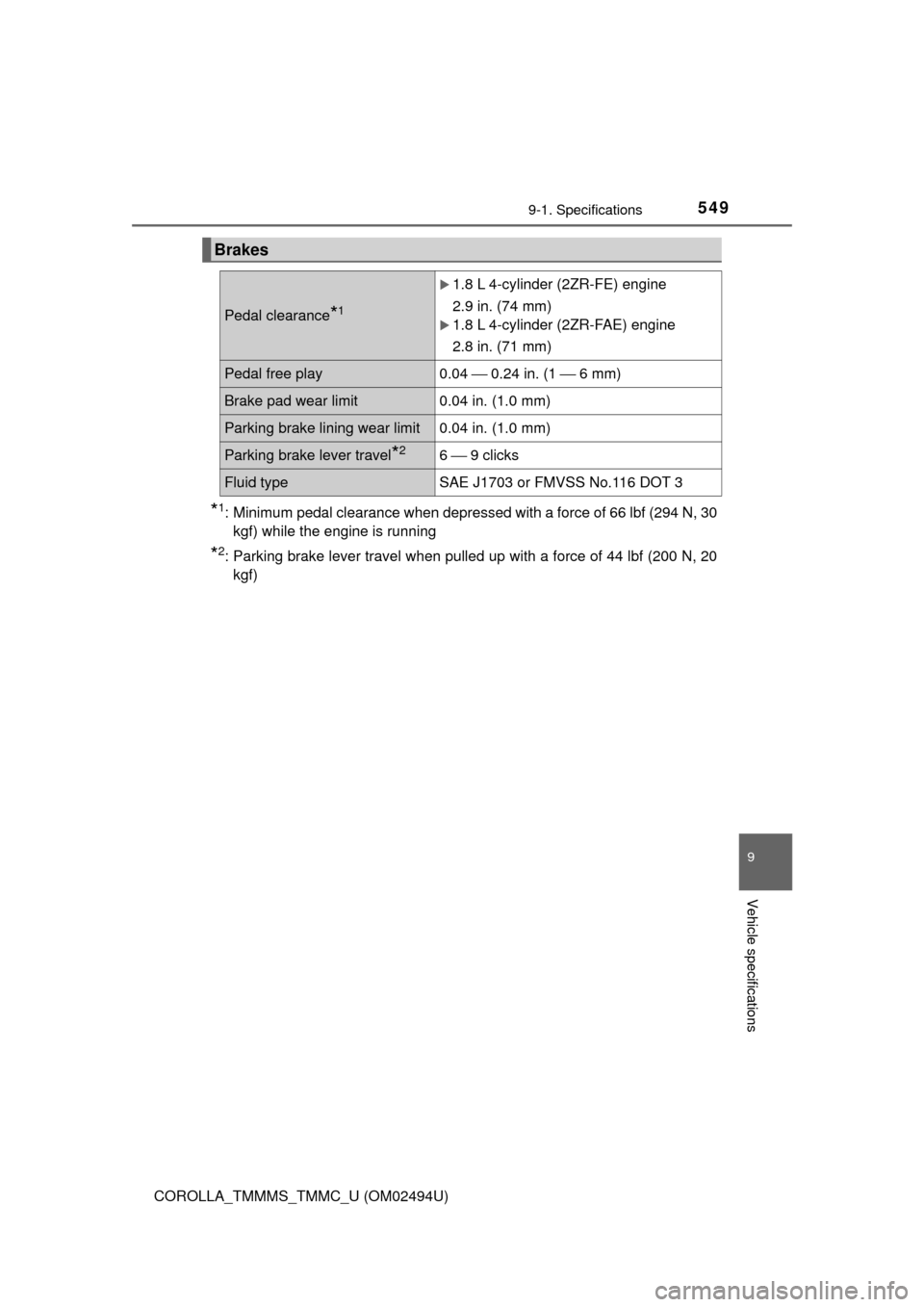2017 TOYOTA COROLLA brake pad
[x] Cancel search: brake padPage 3 of 612

3
1
9 8 6 5
4
3
2
COROLLA_TMMMS_TMMC_U (OM02494U)
10
7
3-1. Key information
Keys .................................. 104
3-2. Opening, closing and
locking the doors
Doors................................. 110
Trunk ................................. 119
Smart key system.............. 124
3-3. Adjusting the seats
Front seats ........................ 132
Rear seats ......................... 134
Head restraints .................. 136
3-4. Adjusting the steering
wheel and mirrors
Steering wheel .................. 139
Inside rear view mirror....... 141
Outside rear view
mirrors ............................. 143
3-5. Opening and closing
the windows
Power windows ................. 145
Moon roof .......................... 1494-1. Before driving
Driving the vehicle ............. 154
Cargo and luggage ............ 165
Vehicle load limits .............. 168
Trailer towing ..................... 169
Dinghy towing (vehicles
with a continuously
variable transmission) ..... 170
Dinghy towing (vehicles
with a manual
transmission) ................... 171
4-2. Driving procedures
Engine (ignition) switch
(vehicles without a
smart key system) ........... 173
Engine (ignition) switch
(vehicles with a smart
key system) ..................... 176
Continuously variable
transmission (vehicles
without paddle shift
switches) ......................... 183
Continuously variable
transmission (vehicles
with paddle shift
switches) ......................... 186
Manual transmission.......... 191
Turn signal lever ................ 193
Parking brake .................... 194
4-3. Operating the lights
and wipers
Headlight switch ................ 195
Automatic High Beam ........ 200
Windshield wipers and
washer ............................. 204
3Operation of each
component4Driving
Page 153 of 612

153
4Driving
COROLLA_TMMMS_TMMC_U (OM02494U)4-1. Before driving
Driving the vehicle ............. 154
Cargo and luggage ........... 165
Vehicle load limits ............. 168
Trailer towing..................... 169
Dinghy towing (vehicles
with a continuously
variable transmission) ..... 170
Dinghy towing (vehicles
with a manual
transmission)................... 171
4-2. Driving procedures
Engine (ignition) switch
(vehicles without a
smart key system) ........... 173
Engine (ignition) switch
(vehicles with a smart
key system) ..................... 176
Continuously variable
transmission (vehicles
without paddle shift
switches) ......................... 183
Continuously variable
transmission (vehicles
with paddle shift
switches) ......................... 186
Manual transmission ......... 191
Turn signal lever................ 193
Parking brake .................... 1944-3. Operating the lights and
wipers
Headlight switch ................ 195
Automatic High Beam ....... 200
Windshield wipers and
washer ............................ 204
4-4. Refueling
Opening the fuel tank
cap .................................. 206
4-5. Using the driving
support systems
Toyota Safety Sense P ..... 209
PCS (Pre-Collision
System)........................... 216
LDA (Lane Departure
Alert with steering
control) ............................ 230
Dynamic radar cruise
control ............................. 240
Rear view monitor
system ............................ 252
Driving assist systems ...... 262
4-6. Driving tips
Winter driving tips ............. 268
Page 159 of 612

1594-1. Before driving
4
Driving
COROLLA_TMMMS_TMMC_U (OM02494U)
WARNING
Observe the following precautions.
Failure to do so may result in death or serious injury.
■When driving on slippery road surfaces
●Sudden braking, acceleration and steering may cause tire slippage and
reduce your ability to control the vehicle.
●Sudden acceleration, engine braking due to shifting, or changes in engine
speed could cause the vehicle to skid.
●After driving through a puddle, lightly depress the brake pedal to make
sure that the brakes are functioning properly. Wet brake pads may prevent
the brakes from functioning properly. If the brakes on only one side are wet
and not functioning properly, steering control may be affected.
■When shifting the shift lever
●Vehicles with a continuously variable transmission: Do not let the vehicle
roll backward while the shift lever is in a driving position, or roll forward
while the shift lever is in R.
Doing so may cause the engine to stall or lead to poor brake and steering
performance, resulting in an accident or damage to the vehicle.
●Vehicles with a continuously variable transmission: Do not shift the shift
lever to P while the vehicle is moving.
Doing so can damage the transmission and may result in a loss of vehicle
control.
●Do not shift the shift lever to R while the vehicle is moving forward.
Doing so can damage the transmission and may result in a loss of vehicle
control.
●Do not shift the shift lever to a driving position while the vehicle is moving
backward.
Doing so can damage the transmission and may result in a loss of vehicle
control.
●Moving the shift lever to N while the vehicle is moving will disengage the
engine from the transmission. Engine braking is not available when N is
selected.
●Vehicles with a continuously variable transmission: Be careful not to shift
the shift lever with the accelerator pedal depressed. Shifting the shift lever
to a gear other than P or N may lead to unexpected rapid acceleration of
the vehicle that may cause an accident and result in death or serious
injury.
Page 160 of 612

1604-1. Before driving
COROLLA_TMMMS_TMMC_U (OM02494U)
WARNING
Observe the following precautions.
Failure to do so may result in death or serious injury.
■If you hear a squealing or scraping noise (brake pad wear limit indica-
tors)
Have the brake pads checked and replaced by your Toyota dealer as soon
as possible.
Rotor damage may result if the pads are not replaced when needed.
It is dangerous to drive the vehicle when the wear limits of the brake pads
and/or those of the brake discs are exceeded.
■When the vehicle is stopped
●Do not race the engine.
If the vehicle is in any gear other than P (continuously variable transmis-
sion) or N, the vehicle may accelerate suddenly and unexpectedly, caus-
ing an accident.
●Vehicles with a continuously variable transmission: In order to prevent
accidents due to the vehicle rolling away, always keep depressing the
brake pedal while the engine is running, and apply the parking brake as
necessary.
●If the vehicle is stopped on an incline, in order to prevent accidents caused
by the vehicle rolling forward or backward, always depress the brake pedal
and securely apply the parking brake as needed.
●Avoid revving or racing the engine.
Running the engine at high speed while the vehicle is stopped may cause
the exhaust system to overheat, which could result in a fire if combustible
material is nearby.
■When the vehicle is parked
●Do not leave glasses, cigarette lighters, spray cans, or soft drink cans in
the vehicle when it is in the sun.
Doing so may result in the following:
• Gas may leak from a cigarette lighter or spray can, and may lead to a
fire.
• The temperature inside the vehicle may cause the plastic lenses and
plastic material of glasses to deform or crack.
• Soft drink cans may fracture, causing the contents to spray over the
interior of the vehicle, and may also cause a short circuit in the vehicle’s
electrical components.
Page 183 of 612

1834-2. Driving procedures
4
Driving
COROLLA_TMMMS_TMMC_U (OM02494U)
Vehicles without a smart key system:
While the engine switch is in the “ON” position, depress the
brake pedal and move the shift lever.
Vehicles with a smart key system:
While the engine switch is in IGNITION ON mode, depress the
brake pedal and move the shift lever.
When shifting the shift lever between P and D, make sure that the
vehicle is completely stopped.
Continuously variable transmission (vehi-
cles without paddle shift switches)
∗
∗: If equipped
Shifting the shift lever
Page 186 of 612

1864-2. Driving procedures
COROLLA_TMMMS_TMMC_U (OM02494U)
Vehicles without a smart key system:
While the engine switch is in the “ON” position, depress the
brake pedal and move the shift lever.
Vehicles with a smart key system:
While the engine switch is in IGNITION ON mode, depress the
brake pedal and move the shift lever.
When shifting the shift lever between P and D, make sure that the
vehicle is completely stopped.
Continuously variable transmission (vehi-
cles with paddle shift switches)
∗
∗: If equipped
Shifting the shift lever
Page 440 of 612

4407-3. Do-it-yourself maintenance
COROLLA_TMMMS_TMMC_U (OM02494U)
Disconnect the claws and
remove the service cover.
Remove the reservoir cap.
Add brake fluid slowly while checking the fluid level.
■Brake fluid can absorb moisture from the air
Excess moisture in the brake fluid can cause a dangerous loss of braking effi-
ciency. Use only newly opened brake fluid.
2
3
WARNING
■When filling the reservoir
Take care as brake fluid can harm your hands and eyes and damage
painted surfaces.
If fluid gets on your hands or in your eyes, flush the affected area with clean
water immediately.
If you still experience discomfort, see a doctor.
NOTICE
■If the fluid level is low or high
It is normal for the brake fluid level to go down slightly as the brake pads
wear out or when the fluid level in the accumulator is high.
However, if the reservoir needs frequent refilling, there may be a serious
problem. Have the vehicle inspected at your Toyota dealer as soon as pos-
sible.
4
Page 549 of 612

5499-1. Specifications
9
Vehicle specifications
COROLLA_TMMMS_TMMC_U (OM02494U)
*1: Minimum pedal clearance when depressed with a force of 66 lbf (294 N, 30
kgf) while the engine is running
*2: Parking brake lever travel when pulled up with a force of 44 lbf (200 N, 20
kgf)
Brakes
Pedal clearance*1
1.8 L 4-cylinder (2ZR-FE) engine
2.9 in. (74 mm)
1.8 L 4-cylinder (2ZR-FAE) engine
2.8 in. (71 mm)
Pedal free play 0.04 ⎯ 0.24 in. (1 ⎯ 6 mm)
Brake pad wear limit0.04 in. (1.0 mm)
Parking brake lining wear limit0.04 in. (1.0 mm)
Parking brake lever travel*26 ⎯ 9 clicks
Fluid type SAE J1703 or FMVSS No.116 DOT 3